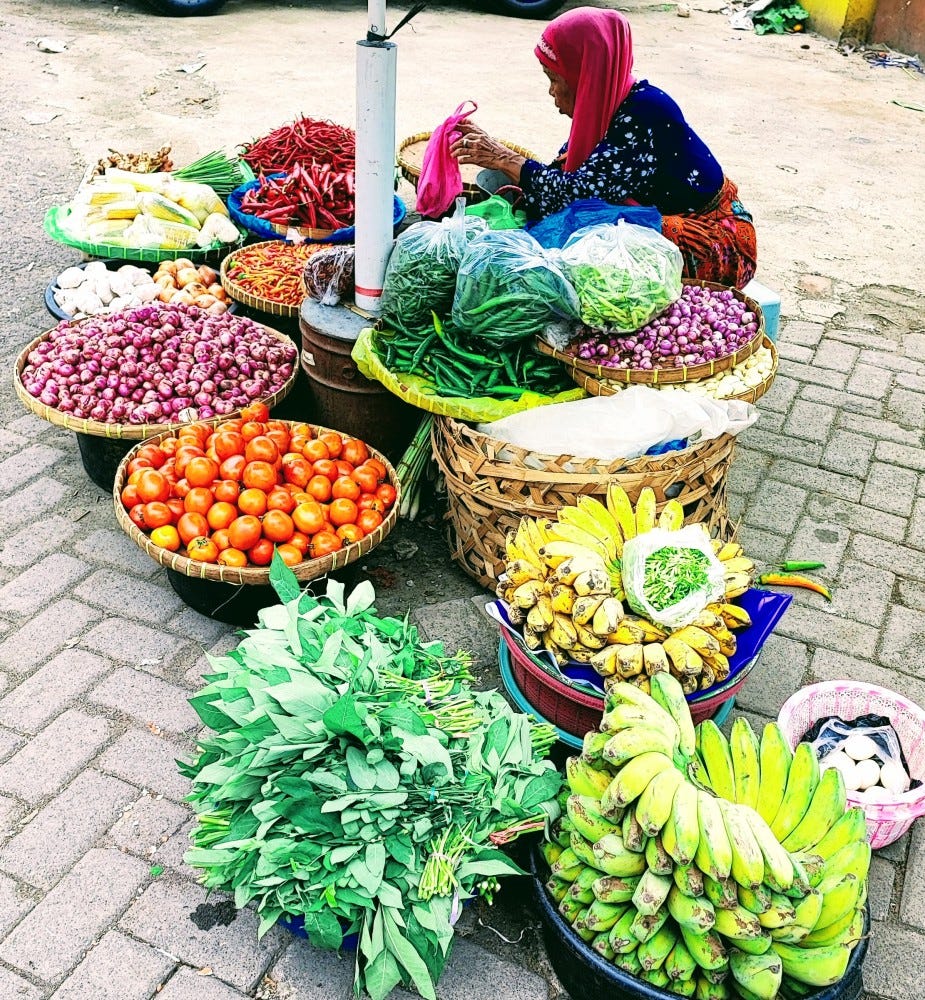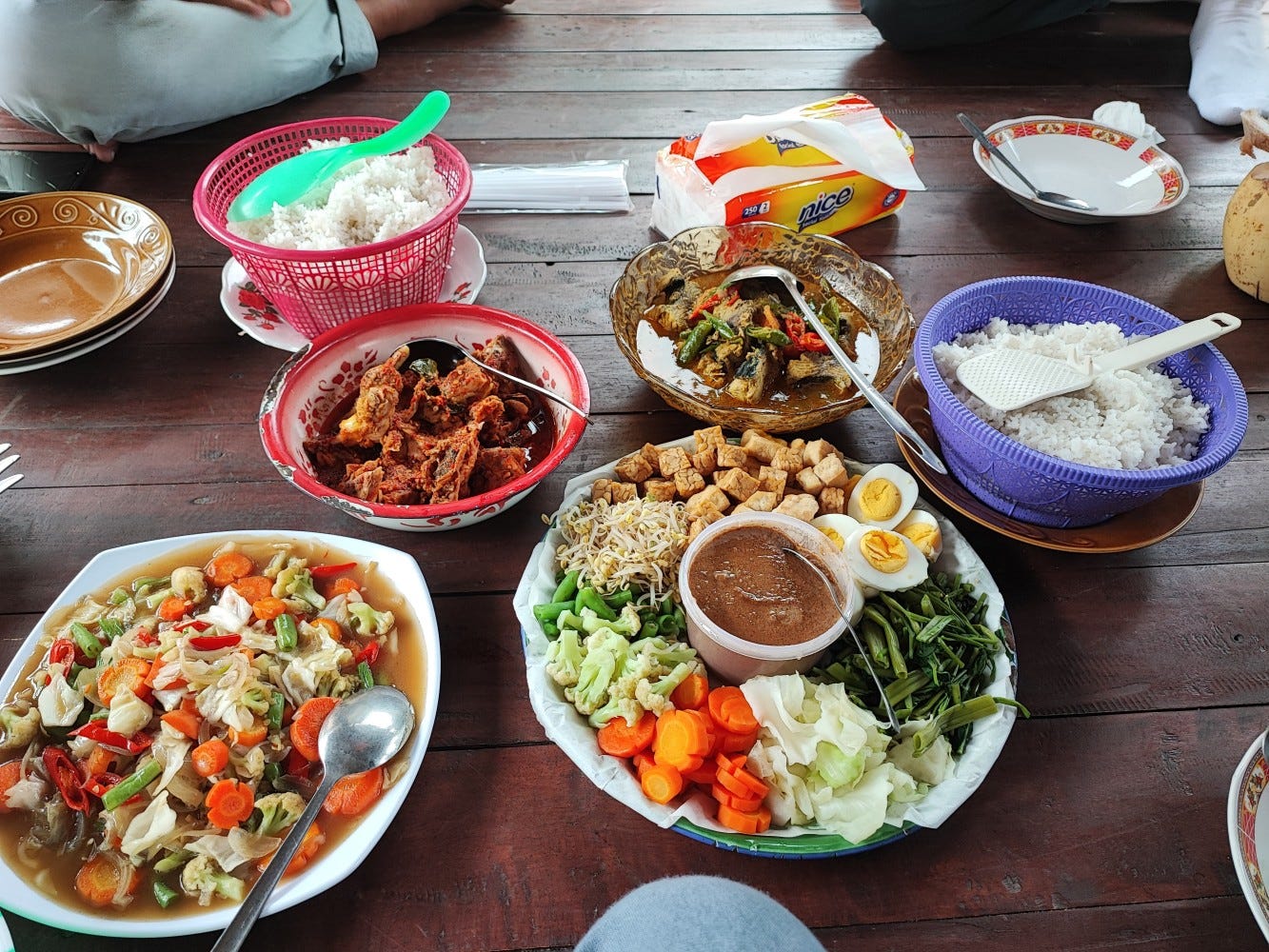Becoming a soul food addict
It’s Monday morning and we have just arrived at the fresh market in Ampenan. Small horse & carts line up on the road outside the market. These are local taxis ready to take people home with their fresh produce. The road is busy with lots of movement as the horse and carts navigate between the scooters, vehicles and people crossing the road. As you enter through the market gates your senses are overwhelmed.
There is a buzz of activity with people moving all around and hawkers selling their fresh produce. Some women are sitting close to the gates with their buckets of goods on the floor and a small umbrella protecting them from the hot sun.
Most of the traders are however located in the large concrete structure that has seen better days. Stalls are packed up tight next to each other and there seems to be some order for where they are placed, or not.
The first thing that catches your eye is the bright colours of the different fruit and vegetables. Hues of bright red, green and orange stand out in contrast against the off-white concrete structure. As you navigate through the stalls your senses start to pick up the different spices, which are neatly stacked up in large containers. You can’t miss the wide selection of fresh chilies in all different colours, sizes and shapes.
Scattered between the vegetable stalls you will find someone selling fresh chicken that has been slaughtered this morning. As you move deeper into the building you find live seafood including fish, crab, prawns and clams. Most of the crabs are still alive with their claws tied together. The fish is packed on ice, or some are still alive splashing in buckets of fresh water.
You quickly realise that this produce is as fresh as it gets. The fish on sale here was caught early this morning. I sometimes watch these boats pulling up on the beach early in the morning not too far from the market. The bananas were still hanging on some trees yesterday. None of these products were frozen or part of any long logistic chain. They were not checked for size, colour and shape. What you see is what you get, fresh produce in its raw state, no cosmetic modification.
Coming from a big city I am accustomed to walking into a large supermarket and choosing my perfectly shaped fruit from sterile chilled shelves. So, what happens to all the ‘ugly’ fruit and vegetables in the big cities? They become food waste, and when I say waste, I mean waste. They are thrown away. Rejected because they don’t look nice. All the energy and water that went into growing that fruit – thrown away to become compost. How did we get here?
People in Lombok have a very different relationship with their food. Everything they eat is fresh and nothing here goes to waste.
Living on a small island and getting to know the local people has allowed me the opportunity to become friends with the fishermen, with people who grow coconuts, mangoes, papaya and bananas in their gardens. Sometimes when I visit people at their homes, they will go climb the tree in their garden to give me a bag of mangoes to take home. You see these trees everywhere on the island.
Since moving to Lombok our relationship with our food is changing. Trying different food is always an exciting part of traveling. Moving to another country takes it to another level. Fortunately for us, it has not required too much of an adjustment. Firstly, our ancestors who settled in Cape Town, South Africa 300 years ago were from Indonesia. Secondly, modern Cape Malay dishes are a combination of Indonesian and Indian dishes, so we are accustomed to spicy food.
That being said the food is still different, in a good way. The staple diet is Nasi Goreng (fried rice) or Mie Goreng (fried noodles). You will find these two tasty dishes everywhere from formal restaurants to the malls to the warungs along the side of the road. In fact, fried food (Goreng) is very popular – everything from bananas to tofu and tempeh(a nutty-tasting bean cake made from fermented soybeans).
Satay is another favorite- small pieces of seasoned chicken or meat on a bamboo skewer grilled and served with a tasty peanut sauce. This is a national dish and is one of my favorites, tasty and healthy. When I’m on the beach for sunset you will normally find me sitting with a plate of freshly grilled chicken satays and an es teh (ice tea).
Another national dish is Gado-Gado which means "mix-mix", made of a rich mixture of vegetables including bean sprouts, spinach, corn, potatoes, long beans and cabbage. Before you raise your eyebrows let me tell you how it's served. It's normally covered with the tasty peanut sauce and served with fried tofu, tempeh and boiled eggs. This dish has also become a favourite of mine.
Of all the meals we have had in Lombok over the last five months, the tastiest and most memorable ones have been when someone has invited us to their home. The people here are so hospitable and they will go out of their way to make your visit special. Meals are normally served outside on a beruga, a small wooden structure with a thatch roof.
The dinner will be a huge spread and normally includes gado gado and grilled satay both served with the tasty peanut sauce, plecing kangkong - water spinach, bean sprouts, string beans topped with grated coconut and a special chili sauce; fresh fish grilled in a spicey local sauce, one or two curries and lots of rice. And don’t forget the assortment of sambals, a fried-chilli sauce normally made with dried-shrimp paste. A beautiful combination of tastes and flavours to awaken your taste buds and make you feel at home.
Hospitality, food, people and serenity blending together to create real soul food.









